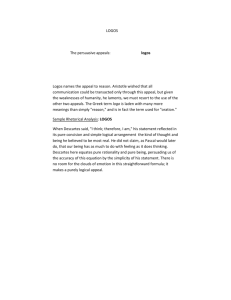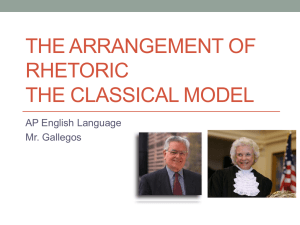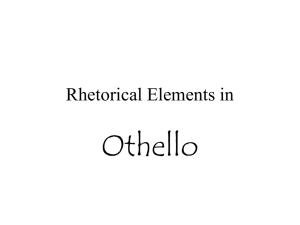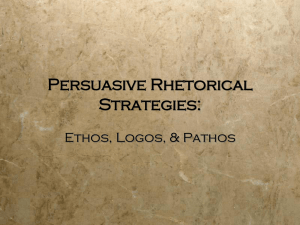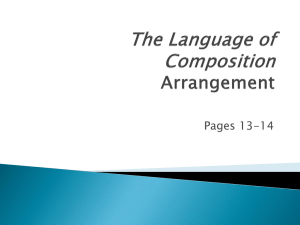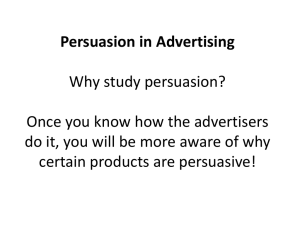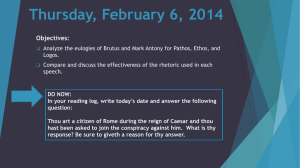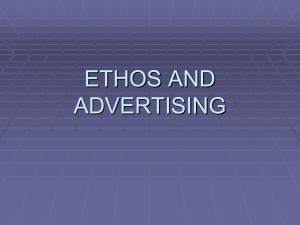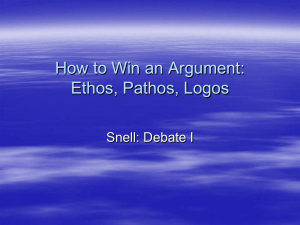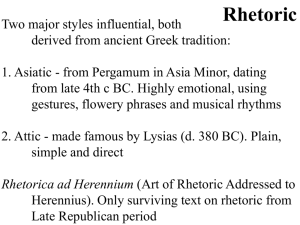The Art of Rhetoric
advertisement
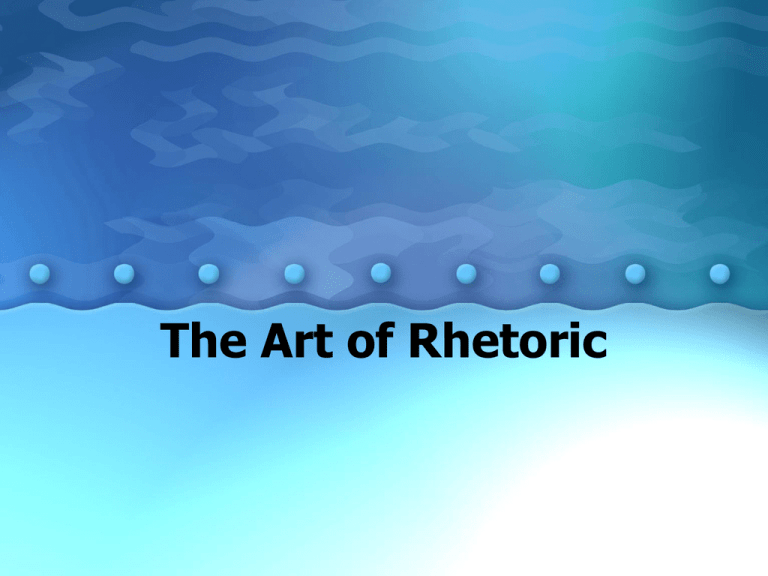
The Art of Rhetoric Rhetoric Rhetoric is the study of effective speaking and writing and the art of persuasion. We study rhetoric in order to: 1) perceive how language works orally and in writing 2) become proficient in applying the resources of language in our own speaking and writing. Persuasive Appeals Persuasion, according to Aristotle, is brought about through three kinds of persuasive appeal: • Logos ~ appeal to reason • Pathos ~ appeal to emotion • Ethos ~ appeal to one's own character Although they can be analyzed separately, these three appeals work together in combination toward persuasive ends. Aristotle calls these "artistic" or "intrinsic" proofs—those that could be found by means of the art of rhetoric—in contrast to "nonartistic" or "extrinsic" proofs such as witnesses or contracts that are simply used by the speaker, not found through rhetoric. LOGOS = REASON Aristotle wished that all communication could be transacted only through this appeal, but given the weaknesses of humanity, he laments, we must resort to the use of the other two appeals. The Greek term logos is laden with many more meanings than simply "reason," and is in fact the term used for "oration." Sample Rhetorical Analysis: When Descartes said, "I think; therefore, I am," his statement reflected in its pure concision and simple logical arrangement the kind of thought and being he believed to be most real. He did not claim, as Pascal would later do, that our being has as much to do with feeling as it does thinking. Descartes here equates pure rationality and pure being, persuading us of the accuracy of this equation by the simplicity of his statement. There is no room for the clouds of emotion in this straightforward formula; it makes a purely logical appeal. Figures of Logos In Logos, speech is used to make an argument more reasonable. • Sorites ~ chain of claims and reasons which build upon one another. • Syllogismus~ the use of a remark or an image which calls upon the audience to draw an obvious conclusion. • Aetiologia ~ figure of reasoning by which one attributes a cause for a statement or claim made. • Ratiocinatio ~ reasoning (typically with oneself) by asking questions. • Anthypophora ~ one asks and then immediately answers one's own questions. • Apophasis~ the rejection of several reasons why a thing should or should not be done and affirming a single one, considered most valid. Figures of Logos, cont… • Contrarium ~ juxtaposing two opposing statements in such a way as to prove the one from the other. • Expeditio ~ after enumerating all possibilities by which something could have occurred, the speaker eliminates all but one. • Proecthesis ~ when, in conclusion, a justifying reason is provided. • Prosapodosis ~ providing a reason for each division of a statement with the reasons usually following the statement in parallel fashion. • Paromologia ~ admitting a weaker point in order to make a stronger one. • Dirimens Copulatio ~ a figure by which one balances one statement with a contrary, qualifying statement • Commoratio ~dwelling on or returning to one's strongest argument. PATHOS = EMOTION We see the close relations between assessment of pathos and of a given audience. Pathos is the category by which we veiw the psychological aspects of rhetoric. Sample Rhetorical Analysis: Antony, addressing the crowd after Caesar's murder in Shakespeare's play, manages to stir them up to anger against the conspirators by drawing upon their pity. He does this by calling their attention to each of Caesar's dagger wounds, accomplishing this pathetic appeal through vivid descriptions combined with allusions to the betrayal of friendship made by Brutus, who made "the most unkindest cut of all": Look, in this place ran Cassius' dagger through; See what a rent the envious Casca made; Through this the well-beloved Brutus stabb'd, And as he pluck'd his cursed steel away, Mark how the blood of Caesar followed it, As rushing out of doors to be resolv'd If Brutus so unkindly knock'd or no; For Brutus, as you know, was Caesar's angel. Judge, O you gods, how dearly Caesar lov'd him! This was the most unkindest cut of all; —Shakespeare, Julius Caesar 3.2.174-183 Figures of Pathos In Pathos, speech is employed to evoke an emotional response. • Adhortatio~ comandment, promise, or exhortation intended to move one's consent or desires. • Aganactesis ~ an exclamation proceeding from deep indignation. • Apagoresis ~ a statement designed to inhibit someone from doing something. • Aposiopesis ~ breaking off suddenly in the middle of speaking, usually to portray being overcome with emotion. • Apostrophe ~ turning one's speech from one audience to another. • Cataplexis ~ threatening or prophecying payback for ill doing. • Conduplicatio ~ the repetition of a word or words in adjacent phrases or clauses, either to amplify the thought or to express emotion. • Deesis ~ the vehement expression of desire put in terms of "for someone's sake" or "for God's sake." • Descriptio ~ vivid description, especially of the consequences of an act, that stirs up its hearers. • Diacope ~ repetition of a word with one or more between, usually to express deep feeling. • Ecphonesis ~ An emotional exclamation. • Energia ~ the vigor with which one expresses oneself. • Epanorthosis ~ mending a first thought by altering it to make it stronger or more vehement. • Epimone ~ persistent repetition of the same plea in much the same words. • Epiplexis ~ asking questions in order to chide, to express grief, or to inveigh. • Excitatio ~ excites an audience, especially out of a stupor or boredom. • Exuscitatio ~ stirring others by one's own vehement feeling. • Inter se Pugnantia ~ using direct address to reprove someone before an audience openly. • Mempsis ~ expressing complaint and seeking help. • Ominatio ~ a prophecy of evil; "ominous" in tone. • Paenismus ~ expressing joy for blessings obtained or an evil avoided. • Perclusio ~ a threat against someone, or something. • Synonymia ~ the use of several synonyms together to amplify or explain a given subject or term; adds force. ETHOS = CHARACTER Ethos refers especially to how character is established by means of the speech or discourse. Aristotle claimed that one needs to appear both knowledgeable about one's subject and benevolent. Cicero said that in classical oratory the initial portion of a speech was the place to establish one's credibility with the audience. Sample Rhetorical Analysis: In Cicero's speech defending the poet Archias, he begins his speech by referring to his own expertise in oratory, for which he was famous in Rome. While lacking modesty, this tactic still established his ethos because the audience was forced to acknowledge that Cicero's public service gave him a certain right to speak, and his success in oratory gave him special authority to speak about another author. In effect, his entire speech is an attempt to increase the respectability of the ethos of literature, largely accomplished by tying it to Cicero's own, already established, public character. Figures of Ethos In Ethos, speech is used to promote the authority and credibility of the speaker. • Anamnesis ~ calling to memory past matters. • Litotes ~ deliberate understatement, especially when expressing a thought by denying its opposite. Serves as a means of downplaying one's accomplishments in order to gain the audience's favor.
